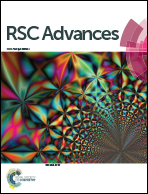The shape memory, and the mechanical and thermal properties of TPU/ABS/CNT: a ternary polymer composite
Abstract
Polymer blend nanocomposites based on thermoplastic polyurethane (TPU) elastomer, acrylonitrile butadiene styrene (ABS) and multi-walled nanotubes (MWCNTs) were prepared via a simple melt blending process. The effects of different nanotube content on the morphology, thermal, mechanical, and shape memory properties of the nanocomposites were investigated. The tensile strength and Young's modulus of the nanocomposites increased, while the elongation at break decreased with the amount of MWCNTs in the blend. The results of the impact test show that the impact strength first increased and then decreased significantly for additions of more than 2 wt% of the filler to the blend. According to the shape memory results, the shape recovery ratios and shape fixity increased significantly only with the addition of 2 wt% of MWCNTs to the blend. Differential scanning calorimetry (DSC) results showed that the addition of MWCNTs reduces the degree of crystallinity and increases the melting temperature of the blend. Furthermore, from the DSC results, we found that that the interaction of MWCNTs with TPU is stronger than with ABS. Thermogravimetric analysis (TGA) studies of the TPU/ABS/MWCNTs nanocomposites exhibit a remarkable thermal resistance much higher than that of the TPU/ABS blend. Finally, scanning electron microscopy (SEM) showed that the added MWCNTs reduced the domain size of the dispersed phase in the blends.


 Please wait while we load your content...
Please wait while we load your content...